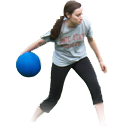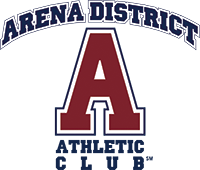
7 Kettlebell Mistakes You’re Probably Making
Training with kettlebells is a crazy-easy way to increase strength and power—as long as you’re using them right. Check out the most common mistakes trainers spot all the time, then clean up your kettlebell act to up your calorie burn and reduce your risk of injury.
1. Your Weight Is Too Heavy
If you’re making the jump from dumbbells, it’s easy to assume that the amount of weight you can handle would be the same. But that assumption would be wrong, as the kettlebell’s shape distributes the weight differently, says Julia Falamas, director of operations at Epic Hybrid Training in New York City. Instead, you need to drop down in weight (and remember, most kettlebells are actually labeled in kilograms, not pounds). “If someone is used to doing a 50-pound shoulder press with a 25-pound dumbbell in each hand, then I’ll start them with 20-pound kettlebells,” she says. “But if you’re not able to maintain the same pace as you could before, or you can’t complete an equal number of reps, then you should drop down some more.”
Starting light is a smart move in general, as it’s an easy way to avoid injury. So if you’re not sure of your weight, Falamas suggests selecting one that’s lighter than what you think you can handle—if you can get through 10 reps easily and don’t feel like it’s taxing, go heavier. Continue that strategy until you’re at a weight where you feel challenged, but can still complete 5 to 10 reps with proper form, she says.
2. You Think You’ll Burn More Calories
While it’s true that kettlebells could burn more calories compared to dumbbells, it’s not a given. “If you’re squatting with kettlebells or dumbbells, the calorie burn isn’t going to change between the two pieces of equipment,” says Falamas. What will rev your calorie burn: “Turning that squat into an explosive movement, like going from a kettlebell swing quickly into a squat, which decreases the time between exercises and increases your calorie burn.” Translation: If you don’t hustle (while keeping good form, of course), you’re not going to stoke that fire any higher.
3. You Wear the Wrong Shoes
Leave your super-cushy running shoes at home; they don’t have a place in your kettlebells routine. Why? The thick soles don’t allow your feet, ankles, and lower ligaments to move naturally, and the higher heel destabilizes your natural grip on the floor.
“The uneven nature of kettlebells[because of their shape] forces you to engage and recruit more muscle fibers in order to perform each movement correctly,” says Marianna Biribin, lead instructor and head of curriculum at Exceed Physical Culture. “Your body is constantly trying to work to balance the inefficiencies created by the weight distribution of the bell,” so not having that natural grip makes it that much harder on you. Opt for minimalist shoes that stay low to the ground instead, or even consider going barefoot, which Falamas has all of her clients do in class. Doing so will give you a bonus workout by strengthening the ligaments and muscles in your feet.
4. You’re Holding It Wrong
When you pick up a kettlebell, the weight should be distributed evenly through a full grip. Then, when you rack it—a common term you’ll hear in adventure race-training gyms and CrossFit boxes (see it here)—your hand should be fully wrapped around the handle, with the weight resting gently against your forearm and wrist. If you’re not doing this, you’ve got improper form. “So many times I see beginners relying on their thumbs to hold the bulk of the weight of a kettlebell when they first pick it up, or they rack it and slam it against their wrist,” says Falamas. What’s it matter? Your thumb isn’t all that strong, and it’s an easy way to set yourself up for injury.
5. You Forget a Critical Part of the Kettlebell Swing
The move is famous for a reason. “Kettlebell swings are the best crossover move between resistance training and cardio training,” says Falamas. And Biribin agrees, saying, “It gives you the most bang for your buck. It combines muscular, cardiovascular, and endurance conditioning into one movement, and challenges the muscles in your posterior chain—muscles in the back of your body—and anterior chain—muscles in the front of your body.”
That said, most beginners don’t perform the very first step of the swing right. After you’re set up correctly with feet slightly wider than shoulder-width apart, shoulders drawn back, chest up, knees slightly bent with the kettlebell between your legs, grab the kettlebelland start with a back swing. “Most people forget this and want to start with a dead hang, and then swing forward,” says Falamas. “But a kettlebellswing is like a pendulum, and you need to swing back and then forward. When you swing back (tilt your torso to about a 45-degree angle—any farther and you risk injuring your lower back) to stretch and engage your hamstrings, which you’ll need to power the swing forward, then drive through your glutes and hips.”
6. You Don’t Finish the Kettlebell Swing
“People forget to drive their hips forward and squeeze their glutes at the top of the swing,” says Falamas. “But we develop power through our glutes, and the purpose of a kettlebell swing is to strengthen the hamstrings and butt. So if you don’t actually squeeze your butt, you’re missing the whole point.” Repeat after us: squeeze, squeeze, squeeze…until you have the buns of steel you’ve always dreamed about.
7. You Don’t Use It Enough
There are so many kettlebell exercises, from explosive and heart-pumping to a slow and steady muscle burn. So if you don’t like one, don’t rule kettlebells out altogether. Falamas’ favorite? Turkish Get-Ups. “It’s one of the best total-body strengthening exercises that you can do because it works your shoulder stability when you hold the kettlebell up in the air, your abs because you stabilize your core through each stage of the exercise, and your legs when you stand up under a heavy load,” she says. “It also works your coordination, which most people take for granted.”
As for Biribin? After the basics are mastered, she’s a fan of more advanced moves you commonly hear about in CrossFit, like the snatch or bottoms-up cleans. But if you’re not quite ready for that, it’s cool. “Don’t feel you have to be doing something that looks crazy or fancy to improve your workouts,” she says. “One of the greatest things about kettlebells is that you can get such an incredible workout from just a few basic moves.”
The Arena District Athletic Club is more than just a gym, it’s a premier fitness facility located in the heart of the Arena District in downtown Columbus. We provide convenience and quality, featuring top-of-the-line equipment, top-notch personal trainers, spa-like locker rooms and a wide variety of free group fitness classes daily including Cardio, Spinning, Barre Fusion, Yoga, Boot Camp and more. We offer free 2-hour parking and convenient contract-free memberships, to fit your healthy lifestyle needs. Don’t just join, belong.





